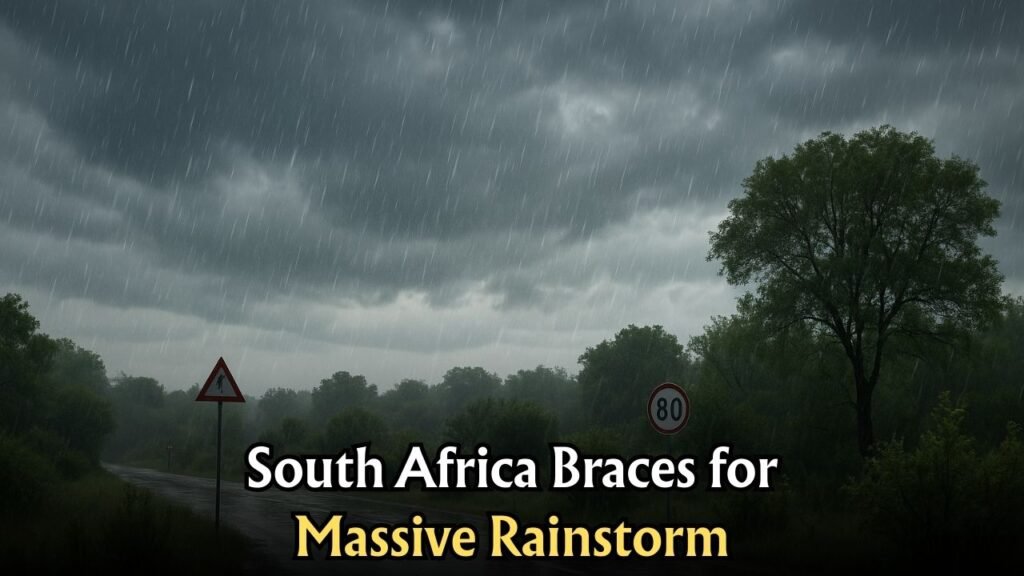Severe Rainstorms in South Africa: The nation is on high alert as meteorologists have predicted an intense series of rainstorms set to sweep across South Africa this week. With the potential for significant impact, citizens are urged to brace themselves for what could be a challenging period of weather. Experts from the South African Weather Service have indicated that these rainstorms are likely to affect various regions, bringing heavy rainfall, strong winds, and the possibility of flooding in certain areas. This weather pattern is not unusual for this time of year, but the severity and wide-reaching impact make it particularly noteworthy. As the nation prepares for these conditions, understanding the potential effects and taking proactive measures will be crucial for minimizing disruptions and ensuring safety.

Impact of Severe Rainstorms Across South African Regions
As the severe rainstorms approach, different regions in South Africa are expected to experience varying degrees of impact. The coastal areas, particularly along the Eastern Cape and KwaZulu-Natal, are likely to bear the brunt of the storms. These regions are prone to heavy rainfall and strong winds, which can lead to significant disruptions. Inland areas, including parts of Gauteng and the Free State, may also experience heavy showers and localized flooding. Such weather conditions can affect daily life, with disruptions to transportation and infrastructure. The agricultural sector, a crucial component of the South African economy, might face challenges due to potential flooding and soil erosion, impacting crop yields and livestock. Citizens in affected regions are advised to stay informed through reliable weather updates and adhere to any safety warnings issued by local authorities. Preparedness and timely response can mitigate the impacts of these severe weather events.
Precautionary Measures Amid Nationwide Severe Rainstorms
In anticipation of the severe rainstorms, it is essential for residents across South Africa to take precautionary measures to safeguard themselves and their property. Ensuring that homes are secure against potential flooding is a critical first step. This includes checking that gutters and drainage systems are clear of debris to prevent water accumulation. Residents should have emergency kits ready, stocked with essentials such as bottled water, non-perishable food, flashlights, and first aid supplies. For those living in areas prone to flooding, having a plan for evacuation is crucial. It’s also advisable to secure outdoor furniture and loose items that could be swept away by strong winds. Motorists should be cautious on the roads, especially in areas where visibility may be poor, and avoid driving through flooded roads. By taking these proactive steps, the safety of individuals and communities can be better maintained during the adverse weather conditions.
Long-term Implications of Severe Weather Events in South Africa
The occurrence of severe rainstorms highlights the broader challenges posed by climate change and its impact on weather patterns in South Africa. As these extreme weather events become more frequent, there are significant implications for infrastructure, agriculture, and community resilience. Investment in robust infrastructure that can withstand severe weather conditions is imperative. This includes improving drainage systems, reinforcing bridges, and ensuring that public transport networks can operate under adverse conditions. The agricultural sector must also adapt by implementing sustainable farming practices that are resilient to weather fluctuations. On a community level, raising awareness and educating citizens about climate change and preparedness strategies can enhance resilience. The government and relevant authorities play a crucial role in facilitating these adaptations, ensuring that South Africa is better equipped to handle the challenges posed by increasingly severe weather events.
Community Response and Support During Severe Rainstorms
Community response is a vital component in managing the impact of severe rainstorms across South Africa. Local communities, NGOs, and government agencies must collaborate to provide support and resources to those affected by the storms. Community centers can serve as shelters for those displaced by flooding, offering safe havens with essential supplies. Volunteers play a crucial role in these efforts, assisting with distribution of relief materials and supporting emergency services. In times of crisis, the power of community solidarity becomes evident, as neighbors help one another and share resources. Social media platforms can be instrumental in disseminating information quickly, allowing for real-time updates on weather conditions and relief efforts. By fostering a spirit of cooperation and mutual support, communities can better navigate the challenges posed by severe weather, ensuring that the most vulnerable are protected and that recovery efforts are efficient and effective.




